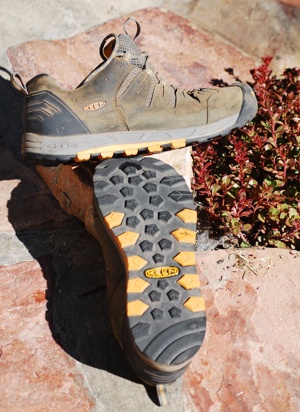KEEN looked to the lofty national parks of Utah when it needed a name for one of its latest entries into the day hiker market, and came up with the Bryce, a stout light hiker with an interesting sole.
A quick glance at the hikers draws the eyes immediately to the filled in arch. Where usually you would see a rise in the sole to somewhat mirror the rise in the arch of your foot, KEEN has filled in that area between the ball of the foot and the heel.
“The idea in filling in that area underneath the arch was to allow the shoe to roll a little bit better, almost have a little bit more ground contact," explains Jeff Dill, the footwear business director of the KEEN Trailhead. "It’s something you see a lot of today in contemporary running products and fast hiking products. And it’s really a comfort thing, whereas the other shoes you have a little dug out or kicker underneath that separates the heel as a distinct area from the forefoot."
The result is a ground-grabbing performance. As you hike the entire surface of the lugged sole -- which you can't miss courtesy of the bright coloring, yellowish-orange, that's integrated into the gray and black sole -- bites into the ground.
There's more to the Bryce (MSRP $135 for mid-ankle version, $125 for low-cut) than sure-footed bite. The upper's carry the distinctive KEEN ribbing: Nubuck leather (from U.S. cows) overlaid a water-resistent breathable mesh liner. The front of the boots feature the company's long familiar rubber toeshield. In the Bryce, that's offset on the other end of the boot with a rubber slip that comes up the heel from the sole.

Bright coloring make it easy to see the filled-in arch and lugging. Notice the rubber shield on the hiker's heel. Kurt Repanshek photo.
The shoes, which tip the scales at 17 ounces, also have KEEN's proprietary waterproof membrane. That might seem a bit odd in a low-cut hiker if you find yourself in soggy wetlands or marshy areas or having to cross a stream, but Dill says that's what the public wants. Plus, the Bryce also comes in a mid-ankle version.
How does the hiker perform?
Thanks to its construction and materials, there's no break-in with these hikers. Right out of the box you can put them to work on trails. The leather upper seemed to provide a firmer, more secure fit, much more than a mesh-only upper. The lacing was quick, snug, and secure. Putting them to work in Theodore Roosevelt National Park on the Ridgeline and Upper Caprock Coulee trails, as well as on the trails around Traveler HQ, the hikers gave a nimble, sure-footed performance that a mountain goat would envy.
Is it more than a day hiker? More than a few backpackers don't mind wearing seemingly light, low-cut hikers, and if you're one of them, the Bryce probably would feel great on your feet, though Dill doesn't recommend them for that use.
"If you’re going to out for several days and have a load greater than a day pack, or maybe a couple days overnight, then I’d recommend a backpacking boot, something with a lot more; a stiffer collar, a little more ankle support, a little more durable," he says. "What this shoe is really good for is day hiking or long weekend stuff, fast hiking."
With that filled-in arch, the Bryce also won't necessarily stop on a dime on downhill stretches with a load on your back as a true backpacking boot would do, which is another reason to watch how you use these.
If you're not accustomed to low-cut hikers, you might worry about rolling an ankle, but don't let that dissuade you from giving these a shot, unless you have weak ankles or are prone to rolling them when you hike. If that's the case, consider the mid-ankle model.
The Bryce is scheduled to come to market in July.


 Support Essential Coverage of Essential Places
Support Essential Coverage of Essential Places







Add comment